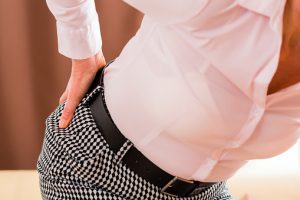 Lumbar spondylosis is a degenerative condition that develops gradually over time, being more common in older individuals. This condition can also be referred to as spinal osteoarthritis. It occurs due to the wear-and-tear of the bones that happens from normal everyday movement. The lower spine is composed of disc-like structures that are cushioned by soft gel-like sections in between them. The purpose of these sections is to promote flexibility and absorb the load of stress applied to the vertebra. Degeneration of these areas causes a loss of elasticity and a propensity to be torn or damaged. If this type of damage were to occur, it may lead to a condition called disc prolapse, disc herniation, or a slipped disc—a common feature of lumbar spondylosis.
Lumbar spondylosis is a degenerative condition that develops gradually over time, being more common in older individuals. This condition can also be referred to as spinal osteoarthritis. It occurs due to the wear-and-tear of the bones that happens from normal everyday movement. The lower spine is composed of disc-like structures that are cushioned by soft gel-like sections in between them. The purpose of these sections is to promote flexibility and absorb the load of stress applied to the vertebra. Degeneration of these areas causes a loss of elasticity and a propensity to be torn or damaged. If this type of damage were to occur, it may lead to a condition called disc prolapse, disc herniation, or a slipped disc—a common feature of lumbar spondylosis.
Causes and risk factors of lumbar spondylosis
Being a degenerative condition means that it is closely related to the passage of time. The impact that minor trauma occurring throughout one’s life can accumulate until one day the symptoms of lumbar spondylosis present themselves. The following are the various causes and risk factors of the condition.
Advertisement
Causes and risk factors:
- Aging: The most common cause as the passage of time can lead to changes in the bones of the spine and other problems. Unfortunately, this often means that the disease is progressive and irreversible. Being over the age of 40 increases one’s risk for lumbar spondylosis.
- Abnormal spinal movement: Frequent overuse of the back as seen during sports or other physically strenuous activity can put increased amounts of stress on the lumbar vertebrae, leading to injury.
- Generics: Those genetically predisposed to weak bones and ligaments may be at increased risk for injury to the lumbar spine.
- Lifestyle: Certain lifestyle habits affect the integrity of bones. Smoking, for example, decreases the amount of water in your discs, which are needed to absorb impact.
- Obesity: Excess weight put extra load on the joints of the lumbar region, accelerating wear-and-tear of the lumbar joints.
- Prolonged sitting: Puts pressure on the lumbar vertebrae.
- Prior injury: Makes one more susceptible for lumbar spondylosis development.
Lumbar spondylosis symptoms
While just thinking of injuring the bones in the lower back can induce wincing, 37 percent of patients suffering from lumbar spondylosis do not have symptoms initially. But when symptoms do appear, they can present as pain ranging from mild to severe, initially presenting as stiffness in the mornings lasting for more than 30 minutes. Additions symptoms of lumbar spondylosis include:
- Localized pain
- Pain after prolonged sitting
- Worsening pain after repeated movement
- Muscle spasms
- Regional tenderness
- Tingling, numbness in the limbs
- Weakness of affected limb due to possible nerve compression
Diagnosing lumbar spondylosis
Your doctor will first complete a history of the presenting injury, gathering clues on how your particular injury occurred. They will then continue to perform a physical examination, testing for a range of motion and checking to see if there is any pain when pressure is applied to the area. A neurological exam will also allow the doctor to assess nerves, muscle strength, and reflexes. This initial assessment will need to be complemented by more definitive diagnostic testing, which in the case of lumbar spondylosis, comes in the form of image testing. The following are some of the various tests:
- X-Ray: Can show bone spurs on the vertebral bodies of the spine, thickening of the facet joints, and narrowing of the intervertebral disc spaces.
- CT scan: Provides greater image detail and can diagnose narrowing of the spinal canal if present.
- MRI: Shows the most detail of any of the previous tests mentioned, but is also the most expensive. It is ideal for visualizing the intervertebral discs, including the degree of disc herniation if present.
- SPECT: Single-photon emission computed tomography bone scintigraphy can be used to further evaluate patients with suspected spondylolysis
Treating lumbar spondylosis
Having chronic lower back pain can cause a lot of difficulty standing or even sitting, so many treatment options focus on relieving this aspect of lumbar spondylosis. In the case of severe disc prolapse, surgery may be required. Generally, most cases of lumbar spondylosis are considered mild, and the following treatment options are conventionally used:
- Chiropractic care
- Physiotherapy
- Anti-inflammatory/pain medication
- Light exercises, such as yoga or water aerobics
Advertisement
There are also unconventional treatments for lumbar spondylosis that include:
- Steroid epidurals
- Osteopathic manual therapy
- Acupuncture
It is important to understand that spinal disc degeneration is a normal part of aging, but not all causes of back pain are the result of this. By speaking to you doctor and going through some tests, you can get back on your feet in no time.
Related: Lumbar spondylosis exercises, yoga poses, and diet tips to relieve pain
